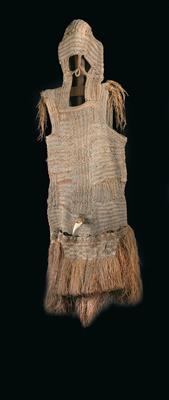New Guinea, South Coast, Asmat territory: A complete mask costume of the Asmat, made of plaited fibre cords, with ornamental decoration.
New Guinea, South Coast, Asmat territory: A complete mask costume of the Asmat, made of plaited fibre cords, with ornamental decoration.

A complete Asmat mask, called ‘jipae’ or ‘jipai’. It consists of plaited parts made of twisted, vegetable rattan cords, sewn together with similar cords. Dyed in red stripes with earth colour.
The hood-like head section features a loop before the face. When using the mask, a typical nose peg of the Asmat, called ‘Bipane’, made of carved bone or shell material, inserted here. On the back of the ‘hood’ are two more loops on top of each other, in which tall ornamental feathers are inserted.
Attached to the front side of the mask costume, in the middle under the knotted nipples, is a plaited male genital, protected by a penis sheath, called ‘koteka’, from the upper part of a hornbill’s beak (‘kotekas’ such as the present one were also worn in everyday life among the Asmat). The lower section of the mask is trimmed with a thickly plaited, all-round band, with a short wickerwork apron in two-colour chequered pattern on the front. The lower edge and the shoulders are covered with tufts of red brown leaf fibres of sago palms.
These ‘jipae’ masks have the following meaning among the Asmat: during grand feasts in commemoration of the dead (‘jipae feasts’) a relative or friend of a recently deceased person appears with this mask, embodying the latter. Thus the dead person participates one last time in the ceremonies, rites and banquets of his community. Subsequently he disappears into the world of the dead forever, and the masked dancer from now onwards acquires all the rights and duties towards the deceased person’s family, children and the community.
This complete ‘jipae mask’ is a rare, extremely interesting object for the history of culture, in good condition, with usage patina (see the openings for the neck and the armpits) and only minor age damage (some threads torn at the bottom).
First third of the 20th century or slightly later; H: c. 145 cm (with hanging), W: 44 cm. (ME)
Provenance: Purchased by the consignor in 1985 in the Asmat village of Manep on the Asewetsi River directly from the Papua. Austrian private collection.
Lit.: ‘Asmat. Leben mit den Ahnen’ by Konrad & Schneebaum, p. 162–171, with numerous illustrations; ‘New Guinea Art’ by Marcia & John Friede, ill. 516; ‘Art in Oceania’ by P. Brunt & N. Thomas, ill. p. 111.
Expert: Prof. Erwin Melchardt
 Prof. Erwin Melchardt
Prof. Erwin Melchardt
+43-1-515 60-465
erwin.melchardt@dorotheum.at
05.11.2014 - 13:00
- Odhadní cena:
-
EUR 6.000,- do EUR 8.000,-
New Guinea, South Coast, Asmat territory: A complete mask costume of the Asmat, made of plaited fibre cords, with ornamental decoration.
A complete Asmat mask, called ‘jipae’ or ‘jipai’. It consists of plaited parts made of twisted, vegetable rattan cords, sewn together with similar cords. Dyed in red stripes with earth colour.
The hood-like head section features a loop before the face. When using the mask, a typical nose peg of the Asmat, called ‘Bipane’, made of carved bone or shell material, inserted here. On the back of the ‘hood’ are two more loops on top of each other, in which tall ornamental feathers are inserted.
Attached to the front side of the mask costume, in the middle under the knotted nipples, is a plaited male genital, protected by a penis sheath, called ‘koteka’, from the upper part of a hornbill’s beak (‘kotekas’ such as the present one were also worn in everyday life among the Asmat). The lower section of the mask is trimmed with a thickly plaited, all-round band, with a short wickerwork apron in two-colour chequered pattern on the front. The lower edge and the shoulders are covered with tufts of red brown leaf fibres of sago palms.
These ‘jipae’ masks have the following meaning among the Asmat: during grand feasts in commemoration of the dead (‘jipae feasts’) a relative or friend of a recently deceased person appears with this mask, embodying the latter. Thus the dead person participates one last time in the ceremonies, rites and banquets of his community. Subsequently he disappears into the world of the dead forever, and the masked dancer from now onwards acquires all the rights and duties towards the deceased person’s family, children and the community.
This complete ‘jipae mask’ is a rare, extremely interesting object for the history of culture, in good condition, with usage patina (see the openings for the neck and the armpits) and only minor age damage (some threads torn at the bottom).
First third of the 20th century or slightly later; H: c. 145 cm (with hanging), W: 44 cm. (ME)
Provenance: Purchased by the consignor in 1985 in the Asmat village of Manep on the Asewetsi River directly from the Papua. Austrian private collection.
Lit.: ‘Asmat. Leben mit den Ahnen’ by Konrad & Schneebaum, p. 162–171, with numerous illustrations; ‘New Guinea Art’ by Marcia & John Friede, ill. 516; ‘Art in Oceania’ by P. Brunt & N. Thomas, ill. p. 111.
Expert: Prof. Erwin Melchardt
 Prof. Erwin Melchardt
Prof. Erwin Melchardt
+43-1-515 60-465
erwin.melchardt@dorotheum.at
|
Horká linka kupujících
Po-Pá: 10.00 - 17.00
kundendienst@dorotheum.at +43 1 515 60 200 |
| Aukce: | Mimoevropské a domorodé umění |
| Typ aukce: | Salónní aukce |
| Datum: | 05.11.2014 - 13:00 |
| Místo konání aukce: | Wien | Palais Dorotheum |
| Prohlídka: | 31.10. - 05.11.2014 |
